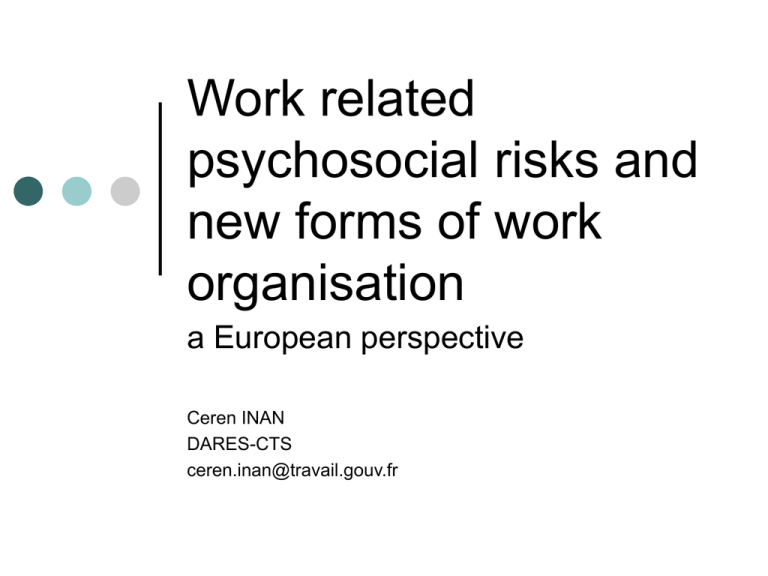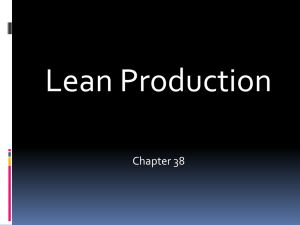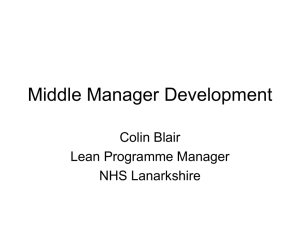a European perspective - `Addressing Quality of Work in Europe
advertisement

Work related psychosocial risks and new forms of work organisation a European perspective Ceren INAN DARES-CTS ceren.inan@travail.gouv.fr Introduction Forms of work organisation typology developed by Valeyre & Lorenz (Valeyre & Lorenz 2003) applied by the authors (and co.) • to 3rd and the 4th EWCS (Valeyre & Lorenz 2004b and 2009) • to business surveys (Bunel M. et al., 2008) used in various studies Typology is based on employees of market sector (workplace size 10 p. or more) Introduction Valeyre & Lorenz Typology Forms of work organisation Lean production forms Discretionary learning forms Taylorist forms Traditional or simple structure forms Introduction Lean production Team work Job rotation Quality management Pace constraints (Womack, Jones and Roos, 1990) Toyota Production System (TPS) Total Quality Management (TQM) Just In Time (JIT) Autonomous teams (AT) Introduction Discretionary learning form of work organisation Autonomy in work Auto-quality of work Autonomous teamwork Learning & problem solving Complex tasks (Berggren 1992) Socio-technical systems Responsible autonomy Adaptability Whole tasks Introduction A fair amount of studies suggest that lean can causes mental harm mostly trough job strain (Landsbergis, Cahill & Schnall, 1999 ; Askenazy 2002) Introduction Job strain is a risk factor for cardiovascular diseases and hypertension musculoskeletal disorders depression chronic stress (Cahill & Landsbergis, 1996; Karasek & Thorell, 1990; Belkic K. et al., 2004; Chouanière D. et al., 2011) Introduction And what about discretionary learning forms of work organisation? causes mental harm? generates stress? or a good alternative to the lean production (regarding PSRs)? Introduction Studies based on the 3rd and the 4th European Working Conditions Survey (EWCS) provides empirical evidence that experienced stress at work, psychosocial risks (PSR) exposure and some psychological troubles (anxiety, insomnia and irritability) are significantly more common among workers in lean production (Valeyre 2006 ; Valeyre et al. 2009) Introduction “Quality of work and employment is clearly better under discretionary learning forms” However, “Only the indicators concerning long working hours and flexible daily working hours, and the psychological working conditions of intrinsic rewards and friendship at work, do not significantly differentiate the discretionary learning and lean production forms”. (Valeyre et al. 2009, page 42) Introduction The aim of this study is to examine the effect of these two new forms of work organisation on work related PSRs of European workers by using the 5th EWCS (for the general survey report, see Parent-Thirion Agnès et al. 2012) Data and method New forms of work organisation in Europe indirectly identified by using an association of 15 organisational variables [see paper] in a multiple correspondence analysis and clustering techniques (for the methodology, see Valeyre & Lorenz 2003, 2004b and 2009) Data and method Psychosocial risks factors 57 variables Specific PSR measures decision latitude, job demands and job strain quality of management Measures on the consequences of PSRs (output) violence at work, experienced stress at work and mental health (WHO-5 score) Data and method multiple correspondence analysis on Psychosocial risks factors focus on the first four dimensions (24% of inertia) regressions on specific PSR measures decision latitude, job demands and job strain (no JCQ, see paper) quality of management regressions on consequences of PSRs (output) violence at work, experienced stress at work and mental health (WHO-5 score) Data and method For each variable 3 types of regression logistic regression, multilevel regression with random effects on intercept at country level (u0) multilevel regression with random effects • on intercept (u0) and • on the effect of Lean production (u1) Data and method multilevel regression with random effect (u0) on intercept (β0) at country level Y=β*X + βLean*Lean + βTaylorist*Taylorist + βSimple*Simple + (β0+u0) / u0 ~> N(0;s2u0) multilevel regression with random effects on intercept (u0) and on the effect of Lean production (u1) Y=β*X + (u1+βLean)*Lean + βTaylorist*Taylorist + βSimple*Simple + (β0+u0) / u0 ~> N(0;s2u0) and u1 ~> N(0;s2u1) Random effects of u0 and u1 covariate as u0 & u1 ~> N(0;0,s2u0;c1;s2u1) In case the covariate of u0 & u1 (C1) could not be estimated, we supposed it to be null (fixed as C1=0) Results - decisional latitude first dimension of MCA opposes employees with low decisional latitude (+) to those with high decisional latitude (-) 1st Dimension Factor No complex tasks Manager rarely helps and supports The job do not offers prospects for career advancement Rarely have the impression work well done Rarely have the feeling doing useful work Do not solves unforeseen problems Rarely autonomy in breaks Do not learn new things Dissatisfying working conditions No autonomy in speed or rate of work Manager do not call participation on decisions Rarely participate, own objectives No autonomy in methods of work No autonomy in order of tasks Rarely participate, important decisions Rarely participate, by own ideas Coord. Contrib. Cos2 0,506 0,017 0,178 0,756 0,019 0,147 0,532 0,020 0,221 1,363 0,021 0,135 1,347 0,024 0,160 0,875 0,025 0,187 0,627 0,025 0,253 0,703 0,026 0,236 0,998 0,030 0,219 0,706 0,031 0,300 0,713 0,032 0,315 0,737 0,032 0,302 0,697 0,034 0,360 0,718 0,036 0,386 0,731 0,038 0,398 0,903 0,046 0,420 Results - decisional latitude first dimension of MCA opposes employees with low decisional latitude to those with high decisional latitude Employees with low decisional latitude Taylorist Elementary occupations Plant and machine operators, and assemblers Simple structures Manufacture Transport and storage Employees with high decisional latitude Learning Managers Professionals Technicians and associate professionals Information and communication Finance and insurance Scientific and tech. activities Results - decisional latitude first dimension of MCA opposes employees with low decisional latitude to those with high decisional latitude Country effect (multilevel reg.) high decisional latitude low decisional latitude Lower Upper P red 0,50 0,00 -0,50 -1,00 -2,00 Norway Finland Denmark Netherlands Latvia Sweden Kosovo Estonia Montenegro Portugal Belgium Malta Ireland Luxembourg United Czech Austria Spain Romania Cyprus Turkey Lithuania Poland France Croatia Slovenia Bulgaria Albania Slovakia FYROM Hungary Italy Greece Germany -1,50 Results - psychological demands second dimension of the MCA opposes the employees undergoing high psychological demands (+) to those having less demanding jobs (-) 2nd Dimension Factor Pace, colleagues work Substantial restructuration or reorganisation Manager is not good at planning and organising work Freq, handles angry clients Asocial working time Manager is not good at resolving conflicts Pace, (prod, or perf,) Targets Freq, must hide feelings Often task interrupted Often homework Dissatisfying working conditions Not enough time to job done Freq, working at high speed Freq, working to tight deadlines Freq, experience stress at work Coord. Contrib. Cos2 0,326 0,016 0,115 0,392 0,017 0,099 0,596 0,018 0,073 0,823 0,018 0,067 0,576 0,019 0,083 0,604 0,020 0,086 0,390 0,023 0,159 0,588 0,023 0,104 0,551 0,026 0,126 0,950 0,026 0,100 0,713 0,027 0,112 1,046 0,035 0,135 0,575 0,040 0,235 0,608 0,048 0,299 0,793 0,052 0,250 Results - psychological demands second dimension of the MCA opposes the employees undergoing high psychological demands to those having less demanding jobs Employees with high psychological demands Lean Managers & Professionals Turkey & France Establishments big in size Industry Employees with low psychological demands Simple Poland Elementary occupations Establishments small in size Administrative and support Results - psychological demands second dimension of the MCA opposes the employees undergoing high psychological demands to those having less demanding jobs Country effect (multilevel reg.) low psychological demands high psychological demands Lower Upper P red 2,00 1,50 1,00 0,50 0,00 -0,50 -1,50 Albania Poland Bulgaria Portugal Latvia Lithuania Croatia Slovakia Czech Kosovo Denmark Montenegro Spain Netherlands Romania Italy Estonia Norway Luxembourg Sweden Belgium Austria FYROM Germany Finland United Ireland Hungary Malta France Slovenia Greece Cyprus Turkey -1,00 Results – job strain plan resulting from these first two dimensions (17% of the inertia), presents a similar structure with the Karasek’s demand-control model Results - multiple correspondence analysis (MCA) Results - multiple correspondence analysis (MCA) Active Jobs High-strain Low-strain Passive Jobs Active Jobs High-strain Low-strain Passive Jobs Active Jobs High-strain Low-strain Passive Jobs Results – job strain Effect of organisational forms (βorg) on job strain Higher odds in Lean and Taylorist organisation to have job strain So, less chance to have a job strain in discretionary learning type of work organisation Observed Logistic Multilevel 2,0 1,5 βorg 1,0 0,5 ref. 0,0 Lean Learning Simple T aylorist -3 Albania Poland Latvia Portugal Norway Kosovo Netherlands Denmark Sweden Finland Bulgaria Croatia Belgium Lithuania Estonia Montenegr Slovakia Czech Romania Spain Italy Ireland United Luxembour Malta Austria FYROM France Hungary Cyprus Slovenia Germany Turkey Greece Results – job strain Country effect (multilevel reg.) No Job Strain Job Strain Lower Upper P red 0 -0,5 -1 -1,5 -2 -2,5 Results – perceived quality of management Third dimension of the MCA opposes well managed close to high-strain jobs to mismanaged passive-jobs Fourth dimension of the MCA opposes some public related external risks to hierarchy related internal risks In both cases the quality of management is an important factor Results – perceived quality of management Better perception of quality of management in discretionary learning type of work organisation In Lean, the perception of quality of management is not bad The perception of quality of management is clearly worst in Simple and Taylorist organisation Effect of organisational forms on the perception of the quality of management (βorg) Observed Logistic Multilevel 1 βorg 0,8 0,6 0,4 0,2 ref. 0 Lean Learning Simple T aylorist -3,50 Cyprus Kosovo Greece Montenegro Portugal Bulgaria FYROM Malta Albania Croatia Ireland Romania Spain Latvia Hungary Norway Czech Slovenia Estonia United Slovakia Poland Lithuania Turkey Finland Sweden Denmark Austria France Belgium Luxembourg Germany Netherlands Italy Results – quality of management In “more developed” European countries employees are more critic about the quality of the management Quality of management Not bad Bad Lower Upper P red 0,00 -0,50 -1,00 -1,50 -2,00 -2,50 -3,00 Conclusion – job strain Lean and Taylorist organisation More demanding jobs Lesser decisional latitude Relatively higher odds to have job strain Observed trough multiple correspondence analysis Verified by regressions Conclusion - violence at work, experienced stress at work and mental health (WHO-5 score) Lean and Taylorist organisation Higher levels of experienced stress in work More violence (verbal abuse; unwanted sexual attention; humiliating behaviour; physical violence; bullying; sexual harassment) Higher odds to have mental health at risk (WHO-5 score) …than Discretionary learning type of work organisation Thank you for your attention !








